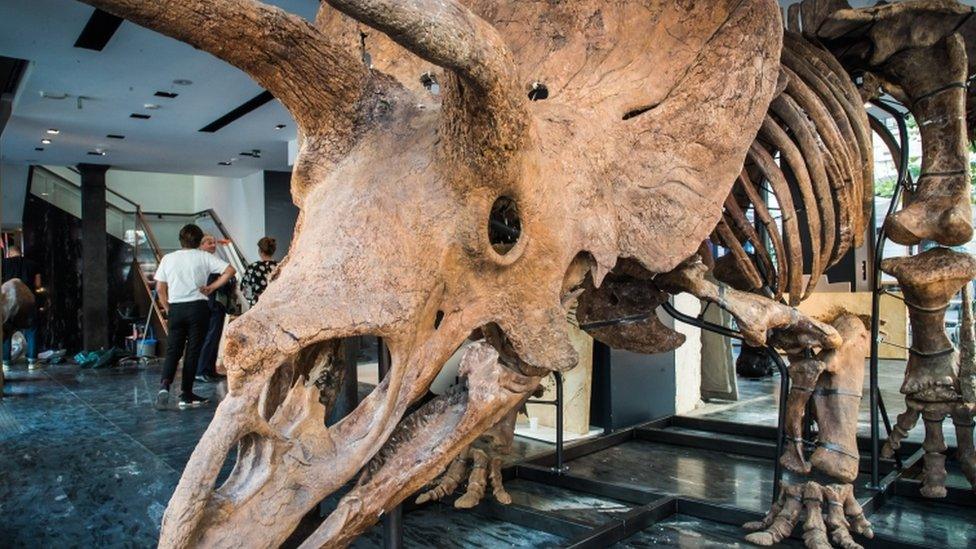Big John: The world's largest triceratops skeleton sells for ÔéČ6.65m
- Published
- comments

The fossilised skeleton of the largest triceratops ever discovered has sold for 6.65 million euros (£5.6 million) at a Paris auction.
The triceratops, named 'Big John', is an absolute beast, even by dinosaur standards.
Having lived 66 million years ago, Big John is recognisable as a triceratops because of the shape and size of its skull.
Triceratops have two long horns above the eyes and a smaller horn between the nostrils.
Big John's two larger horns are both over a metre long and over 30cm wide at their base, meaning they could have each supported a weight of 16 tonnes - that's the combined weight of over 20 cows!
The animal died on an ancient floodplain, in an area that is now known as the Hell Creek Formation in South Dakota, US. The conditions there meant that his bones were perfectly preserved in mud.
More than 200 bones were carefully assembled
Some parts of the skeleton are missing though and the fossil of Big John's huge head is only about 75% complete.
Cleaning, restoring and reconstructing Big John to (almost) all its fully-formed glory took thousands of hours and now, following the auction, the fossilised remains will be sent to a private buyer based in the US.
The giant dino was named Big John after the owner of the land where it was found.
1. The name triceratops, which comes from the Greek language, means three-horned face.
2. Despite its scary appearance, the triceratops was actually a herbivore!
3. Triceratops had hundreds of teeth! These were arranged in groups called batteries and the dinosaurs used their gnashers to chop through tough vegetation.
The fossilised remains of 'Big John', the largest triceratops dinosaur ever discovered, were sold to a unidentified private seller for ÔéČ6.65m (┬ú5.6 million)
How do you buy and sell dinosaur fossils?
In the past, it was mainly research centres and museums that would buy fossils. However, there is now a growing trend for fossils to be bought and collected by private buyers.
Celebrity buyers, such as Hollywood actors Leonardo DiCaprio, Nicolas Cage and Russell Crowe, are known to have bought prehistoric treasures in recent years.
Today you can even buy genuine dinosaur fossils online - there's currently an incomplete skull from another smaller triceratops, placed at £180,000 on the buying and selling site eBay.
But, it has started a debate about whether private buyers should be allowed to purchase dinosaur fossils because they can often outspend museums at auctions.
Trix, one of the best preserved fossils of a Tyrannosaurus at an exhibition at the National Museum of Natural History in Paris
In an interview with the 91╚╚▒Č, Dr Susannah Maidment from the Earth Sciences department of London's Natural History Museum said: "The problem is these specimens go on sale for huge amounts of money, far more than museums can afford."
Explaining that the museum has a budget of "tens of thousands of pounds" each year, she added that: "Many of these big dinosaur specimens will sell for well over a million dollars".
Some dinosaur experts, known as palaeontologists, say that private collectors buying fossils denies research teams the opportunity to study the ancient animals further.
An American organisation representing palaeontologists, called the Society for Vertebrate Paleontology (SVP), wrote to an auction house selling a dinosaur fossil in 2018 asking for the sale to be cancelled.
"Fossil specimens that are sold into private hands are lost to science," they said in the letter.
Who owns a fossil once it's found?
Fossilised dinosaur bones are often uncovered by research teams of palaeontologists, but there are also private fossil hunters who excavate and uncover these skeletons either working on behalf of museums, private collectors, or with hopes of selling what they've found to the highest bidder at auction.
And finding dinosaur bones takes a lot of work - it's estimated that a typical elephant-sized dinosaur, can take thousands of hours to excavate and then get ready for display. For many private dinosaur hunters, the money they receive from an auction is a big part of being able to earn a living.
Visitors look at the skeleton of a gigantic Triceratops over 66 million years old, named "Big John", on display before its auction in Paris
While some countries, like the US, will allow private fossil hunters to sell on their finds, lots of others including China, Mongolia and Brazil ban the export of dinosaur remains to private collectors.
For example, the actor Nicolas Cage bought a 70 million-year-old skull of a Tyrannosaurus bataar, an Asian relative to Tyrannosaurus rex, at auction in the US in 2012, but the fossil was later reclaimed by the Mongolian government.
As for Big John, or any other dinosaur fossil found on private land in the US, they can be sold at any price and to anyone in any country.
What do you think of Big John - should it have been sold to a museum instead? Let us know in the comments.
- Published3 September 2021
- Published28 March 2019
- Published17 May 2019
